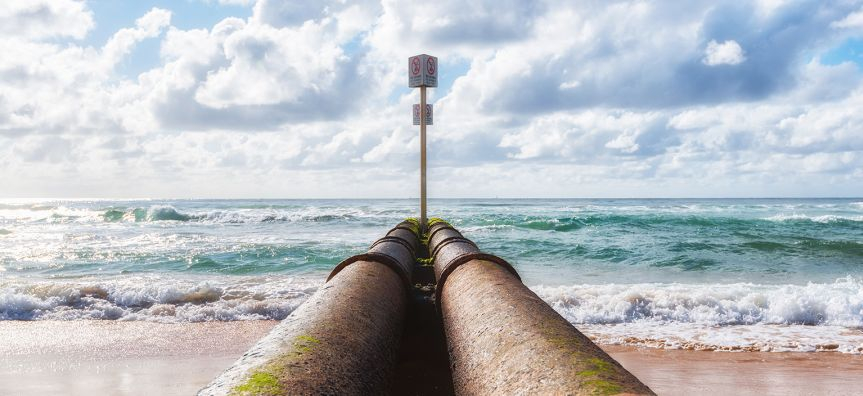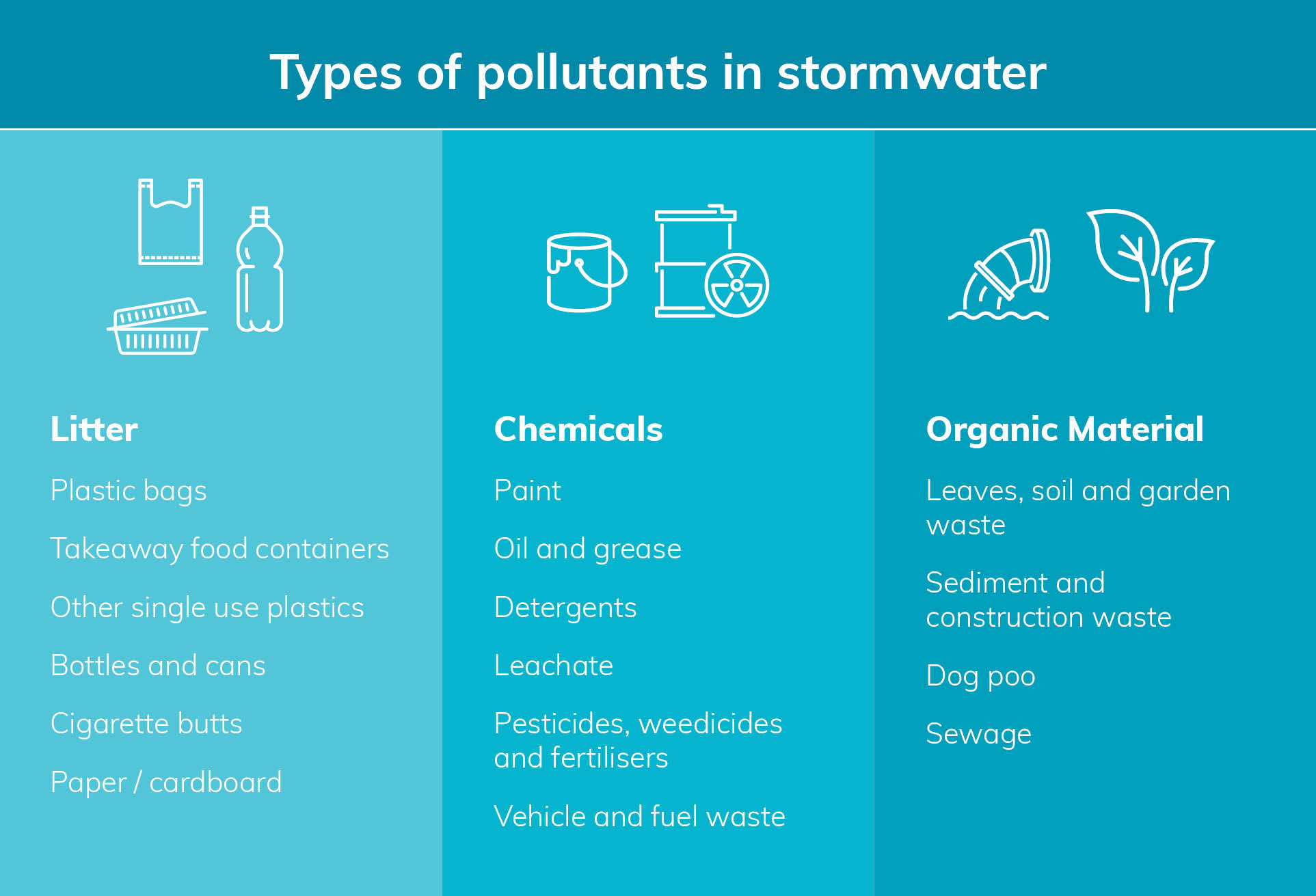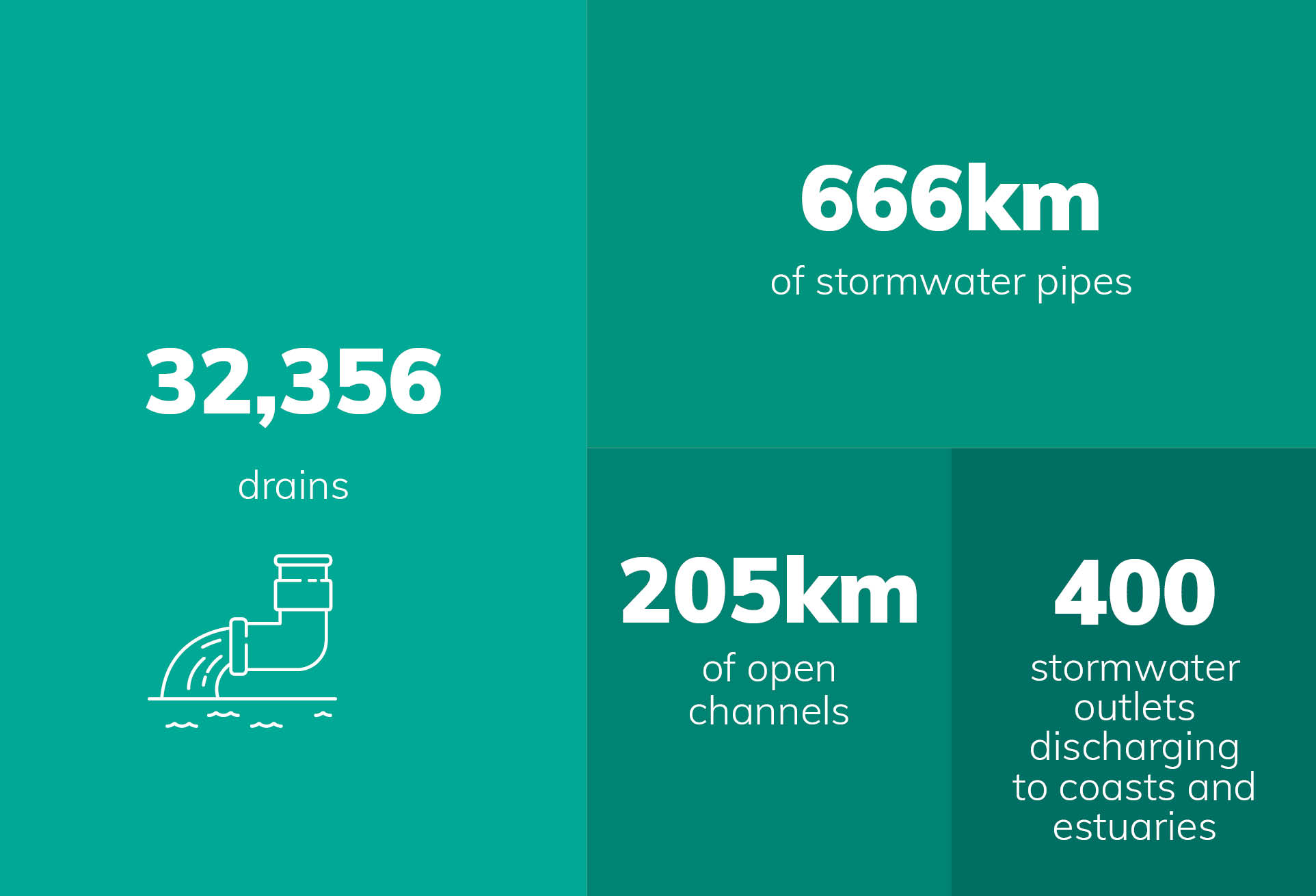
Water Pollution
Did you know that stormwater is the biggest source of water pollution and there is a lot we can do to prevent it?
When it rains, chemicals, oil, sediment, leaf litter and rubbish gets washed into stormwater drains from roofs, gardens, driveways, roads, restaurants, construction sites and factories. Water flows down the street picking up whatever is there, carrying it to our drains and discharging it to our beaches, lakes, rivers and lagoons.
We are all responsible for the impact we have on our environment and should make an effort to be aware of where our rubbish and other pollutants end up.
If you love the coastline of the Northern Beaches and don’t want to be confronted by floating rubbish and other pollution, or see aquatic ecosystems damaged, remember the drain is just for rain.
What is water pollution?
Water pollution is placing in or on water any matter including solids, liquid or gas, so that the physical, chemical or biological condition of the water is changed.
Water pollution can occur from poor building practices, washing cars with detergents in the street, gardeners blowing leaves into gutters and placing chemicals, sediments and other foreign material in a body of water (this includes stormwater channels, drains and roadside street gutters).
The most common water pollution enquiries received by our compliance staff result from inadequate sediment and erosion control on construction sites, followed by sewer overflows, paint/oil spills, swimming pool overflows, industrial areas spills, etc.
Useful links
- How to reduce stormwater pollution (DPIE)
- Report a water pollution issue to Council
- Contacts for water pollution
- Solutions to Pollution: for small businesses
- Waterway Health
- Sydney Water
- Protection of the Environment Operations Act 1997
- NSW Environment Department
- NSW Roads and Maritime Services
- Water Management for Development Policy
How does water move through a catchment?
Water moves from the highest elevation of a landmass to the lowest point due to gravity. When it rains, water flows from the ridges of hills down to rivers and finally the ocean. A catchment is an area of land that is a little like a bath tub - it captures all the water that flows to a particular river system. Ridges, hills and mountains represent the edges of the bathtub and the ocean is the drain.
Water also flows into stormwater drains from roofs, roads and other hard surfaces ending up in outlets to rivers and beaches.
The water also cycles through the catchment, evaporating from water bodies such as the ocean and from the active transpiration of plants - they actively take up water in roots and release it through cells in their leaves. This forms into clouds and falls down onto the land as rain. Some of the rainwater soaks in the land and flows in underground rivers or aquifers, the rest runs off in to creeks and drains, ending up in the ocean. The rate of runoff flow and the pollutants that are picked up affects the water quality of our waterways and beaches, as well as erosion of land.

Types of pollutants in stormwater
Pollutants that get washed into our stormwater drains include:
Litter
- Plastic bags
- Bottles and cans
- Paper and other packaging
- Cigarette butts
- Takeaway containers and cutlery
Chemicals
- Paint
- Oils and fuel
- Detergent
- Pesticides and fertilisers
- Commercial waste
Organic material
- Dog poo
- Leaves
- Garden clippings
- Soil and sediment
- Sewage overflows

Council's stormwater system
Council looks after:
- 32,356 drains
- 666 km of stormwater pipes
- 205 km of open channels
- ~400 stormwater outlets discharging directly to our coasts and estuaries
What is Council doing about water pollution?
We take pride in being one of the largest coastal Council areas and keeping our beaches and waterways clean is a key focus. To do this we need to improve the quality of water reaching our drains and beaches.
Some of our initiatives include:
- Street sweeping and beach cleaning
- Litter and waste education
- Beautifying areas to attract less litter
- Stormwater Quality Management Strategy (in progress) and development policies
- Compliance and planning controls
- Zero Waste to Ocean Charter
Report water pollution incidents
Please report water pollution incidents and issues to Council. Include the time and date of the incident, details of pollution type and where it was discovered, whether you witnessed the pollution incident occurring, other details of the incident and your contact details.
If the water pollution you’re reporting is urgent, or a hazardous situation you think may cause physical harm to a person or property, please call us 24/7 on 1300 434 434.
Under the Protection of the Environment Operations Act 1997 (POEO Act), Council may serve notices (for fines) on individuals or businesses responsible for water pollution.
What can you do about water pollution?
Help your local creeks, bays and beaches, by being aware of where stormwater pollution comes from and by making an effort to prevent polluting your local catchment.
Watch this video Keeping our waterways clean. Easy ways to help for tips.
Home renovators can find useful tips in the 'Get the Site Right' brochure. Guidelines on managing construction sites for stormwater protection can be found in the Soils and Construction Blue Book.
Also make sure that your contractors operate in an environmentally-responsible manner and put in place appropriate measures for sediment and chemical containment.
When you are gardening please don’t blow or sweep leaves into the gutter - they should be placed in your green bin. Leaves can block gutters causing flooding and pollute our waterways by releasing phosphorous. Excessive amounts of nutrients like phosphorus can cause eutrophication or deplete oxygen in the water, resulting in aquatic animals including fish to die.
Construction sites
- When building, landscaping or renovating, always use appropriate sediment and erosion controls.
- Store chemicals in a properly maintained bunded and covered storage area.
- Keep adequately stocked spill kits on hand and make sure staff know how to use them.
- Never, ever hose chemical spills down the drain.
- Cover sediment piles and ensure appropriate barriers are in place to prevent sediment flowing down the drains.
- Fines apply for pollution incidents.
In your garden
- Use leaves and grass clippings in composting, place in green bins or use on your garden as mulch.
- Cover piles of soil, sand or mulch.
- Build barriers around your garden beds to contain the soil. Plant vegetation to reduce soil erosion.
- Use organic fertilisers.
- Minimise the use of pesticides and weedicides.
- Have your sewer checked.
- Install rainwater tanks and/or systems to divert roof water directly to gardens.
Out and about
- Pick up your dog’s droppings with a biodegradable bag and put it in a bin.
- Don’t litter
- Carry a container for your cigarette butts.
- Carry rubbish home or place in public bins.
- Carry reusable cutlery and straws and reduce single use plastics.
Restaurants and cafés
- Clean up wind-blown takeaway litter.
- Store oil and waste water correctly.
- Clean out your grease trap regularly.
- Try to use reusable or biodegradable cutlery, crockery and containers.
When you maintain your car
- Use a service station car washing bay or a car wash that recycles water.
- Wash your car on lawn and pour any leftover soapy water onto the lawn.
- Regularly service your car to avoid oil leaks.
When you paint and renovate
- Allow unwanted paint to dry out, then take tins to a Chemical CleanOut event or the Kimbriki Resource Recovery Centre or other licensed facility.
- When you use small amounts of water-based paint, clean up over soil.
- Keep oil-based paint, turps and solvents clear of gutters and drains. Do not allow paint to go down the drain.
- Reuse turps once paint has settled.
- Don’t hose sand or gravel, or wash out cement mixers or barrows, allowing it to flow into street gutters.
- Don’t leave piles of sand or gravel uncovered where it can wash or blow into street gutters.
- Fines apply for pollution incidents.
